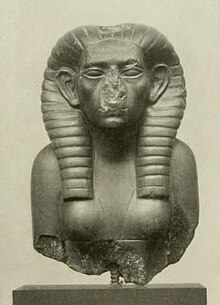Statue of Nofrusobek
A statue of Nofrusobek once stood in the temple of Taharqa in Semna , where it was found during excavations. It is the only statue of this ruler whose head has been preserved. Nofrusobek (around 1810/1793 to 1806/1789 BC) was the first independently ruling queen of Egypt . Various statues of her have been preserved, but they all lack a head. The statue from Semna broke over time. The upper part of the statue came to the Egyptian Museum in Berlin in 1899 (inventory no. 14475). This bust was lost in World War II, but photos and plaster casts have survived.
The head shows a woman with a long wig. The nose broke off. The face shows typical stylistic features of the late Middle Kingdom. Typical of the portraits of this time is above all the depiction of age, which is in contrast to the ageless ideal portraits of other epochs of Egyptian history. The lower part of the statue was unearthed during the excavations by George Andrew Reisner in Semna and ended up in the Museum of Fine Arts in Boston (inventory no. 24.742). It shows a woman in a long robe seated on a cubic throne. For a long time it was not known whether the two parts of the statue belonged together, but the Egyptologist Biri Fay has proven this.
Both parts of the statue are unlabeled, but on the sides of the throne there is the hieroglyphic symbol Union of the Two Countries , with which the statue is clearly royal and can be assigned to Nofrusobek, since she is the only woman of the Middle Kingdom who ruled as queen.
Individual evidence
- ↑ see e.g. B .: Hedwig Fechheimer : The sculpture of the Egyptians. Cassirer, Berlin 1914, plates 57–58.
- ^ Dows Dunham , Jozef MA Janssen: Second cataract forts. Volume 1: Semna Kumma. Museum of Fine Arts, Boston 1960, p. 33, plate 40.
- ↑ Biri Fay, RE Freed, T. Schelper, Friederike Seyfried: Neferusobek Project: Part I . In: G. Miniaci, W. Grajetzki (eds.): The World of Middle Kingdom Egypt (2000–1550 BC) Contributrions on Archeology, Art, Religion, and Written Sources. Volume 1, Golden House Publications, London 2015, ISBN 978-1-906137-43-4 , pp. 89-91. on-line
